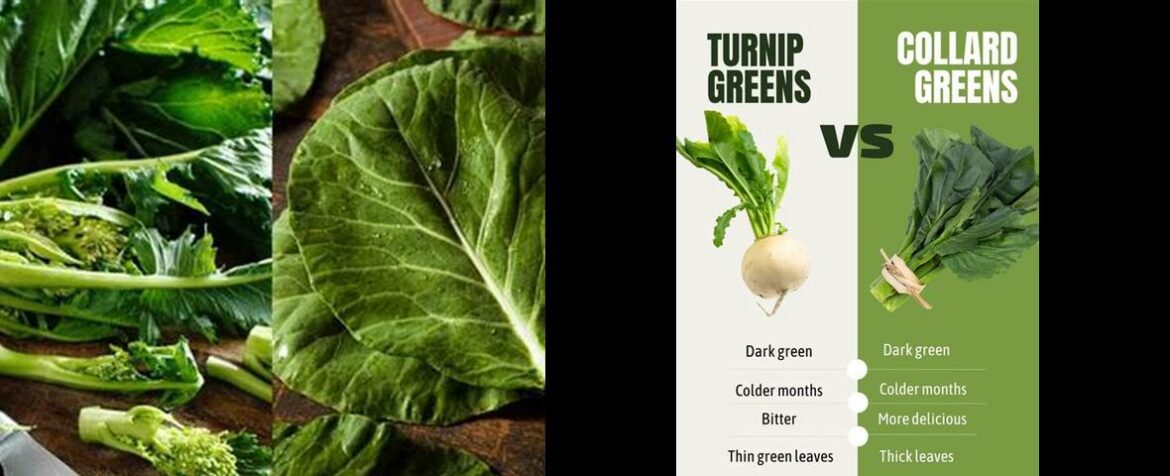Are you ready to dive into the world of leafy greens? Well, get ready to meet the dynamic duo: turnip greens and collard greens! These two leafy delights are often overshadowed by their more popular counterparts like kale and spinach. But hey, don’t underestimate the power of the underdogs! In this blog post, we’re going to unveil the nuances of turnip greens vs collard greens and discover why they deserve a spot on your plate. So, whether you’re a veggie enthusiast or just looking to switch up your greens game, this is the ultimate showdown you don’t want to miss! Let’s get ready to rumble with turnip greens and collard greens!
Turnip Greens Vs Collard Greens: Unveiling the Nuances of Two Leafy Delights
In the realm of leafy greens, turnip greens and collard greens stand out as two culinary gems, each possessing distinct characteristics that add depth and flavor to various dishes. From their contrasting appearances to their unique flavor profiles and nutritional offerings, these two vegetables offer a delightful journey for both the palate and the body. Let’s delve into the world of turnip greens and collard greens, exploring their differences and similarities, and uncovering the culinary magic they bring to our tables.
Appearance: A Tale of Two Greens
Turnip greens, with their vibrant leafy stems, crown the round, purple or white bulbs of the turnip plant. Their leaves, characterized by a serrated edge, display a deep green hue, adding a touch of color to any dish. In contrast, collard greens boast large, dark green leaves that exhibit a smooth and slightly curled texture. These leaves, part of the cabbage family, form a rosette-like structure, adding visual interest to culinary creations.
Flavor and Texture: A Symphony of Tastes and Sensations
Turnip greens and collard greens present distinct flavor profiles that tantalize the taste buds. Turnip greens possess a peppery, slightly bitter flavor, while collard greens offer a milder, more subdued taste. This difference in flavor intensity makes each green suitable for various culinary applications. When cooked, turnip greens retain their vibrant color and soften slightly, while collard greens wilt and shrink, maintaining their dark green hue. Turnip greens, with their crunchy texture, provide a satisfying bite, while collard greens, known for their melting quality, offer a tender, velvety sensation.
Nutritional Powerhouses: Unveiling the Health Benefits
Both turnip greens and collard greens are nutritional powerhouses, packed with an array of essential vitamins, minerals, and antioxidants. They are rich sources of vitamins A, C, and K, as well as calcium and potassium. These nutrients play crucial roles in maintaining healthy bones, supporting a robust immune system, and promoting good eyesight. Additionally, the high fiber content in both greens aids digestion, lowers cholesterol levels, and reduces the risk of heart disease. Turnip greens contain indoles, compounds with potential anticancer properties, while collard greens provide folate, an essential nutrient for pregnant women.
Culinary Delights: Exploring Versatile Ingredients
Turnip greens and collard greens shine in a myriad of culinary creations, adding flavor and nutrition to various dishes. They are commonly sautéed with garlic, onions, and spices, creating a flavorful side dish that complements grilled meats, roasted vegetables, or hearty stews. Alternatively, boiling and mashing these greens results in a creamy, comforting dish that can be enjoyed on its own or incorporated into casseroles and soups. Their versatility extends to salads, sandwiches, and even smoothies, providing a nutritious boost to any meal.
Cooking Techniques: Unlocking the Culinary Potential
To prepare turnip greens and collard greens, a simple yet effective method involves washing and chopping the leaves. Heat oil in a pan or skillet, add garlic and onions, and sauté until fragrant. Incorporate the chopped greens and cook until they wilt. Season with salt, pepper, and additional spices or herbs to enhance the flavor. The cooking time may vary depending on the desired tenderness, but both greens typically require a few minutes to soften. Alternatively, these greens can be boiled or steamed until tender, preserving their vibrant color and nutritional value.
Conclusion: A Celebration of Leafy Delights
Turnip greens and collard greens, with their contrasting flavors, textures, and nutritional profiles, offer a delightful culinary experience. While turnip greens captivate with their peppery bite and crunchy texture, collard greens entice with their milder flavor and melting quality. Both greens are versatile ingredients that can be incorporated into various dishes, from sautéed sides to hearty soups and stews. As nutritional powerhouses, they provide an array of health benefits, supporting overall well-being. Whether enjoyed as a standalone dish or as part of a culinary creation, turnip greens and collard greens are leafy delights that deserve a place in every kitchen.
FAQ about Turnip Vs Collard Greens
Q: What are the main differences between turnip greens and collard greens?
A: Turnip greens have a peppery bite and crunchy texture, while collard greens have a milder flavor and a melting quality.
Q: How can turnip greens and collard greens be used in cooking?
A: Both greens are versatile ingredients that can be incorporated into various dishes, such as sautéed sides, hearty soups, and stews.
Q: What do turnip greens and collard greens look like?
A: Turnip greens have vibrant leafy stems and deep green leaves with a serrated edge. Collard greens have large, dark green leaves with a smooth and slightly curled texture.
Q: What are the health benefits of turnip greens and collard greens?
A: Turnip greens and collard greens are nutritional powerhouses that provide an array of health benefits, supporting overall well-being.
Q: Can turnip greens and collard greens be enjoyed as standalone dishes?
A: Yes, both turnip greens and collard greens can be enjoyed as standalone dishes, as well as part of culinary creations.
Q: Are turnip greens and collard greens suitable for all kitchens?
A: Yes, turnip greens and collard greens are leafy delights that deserve a place in every kitchen, regardless of culinary preferences.


